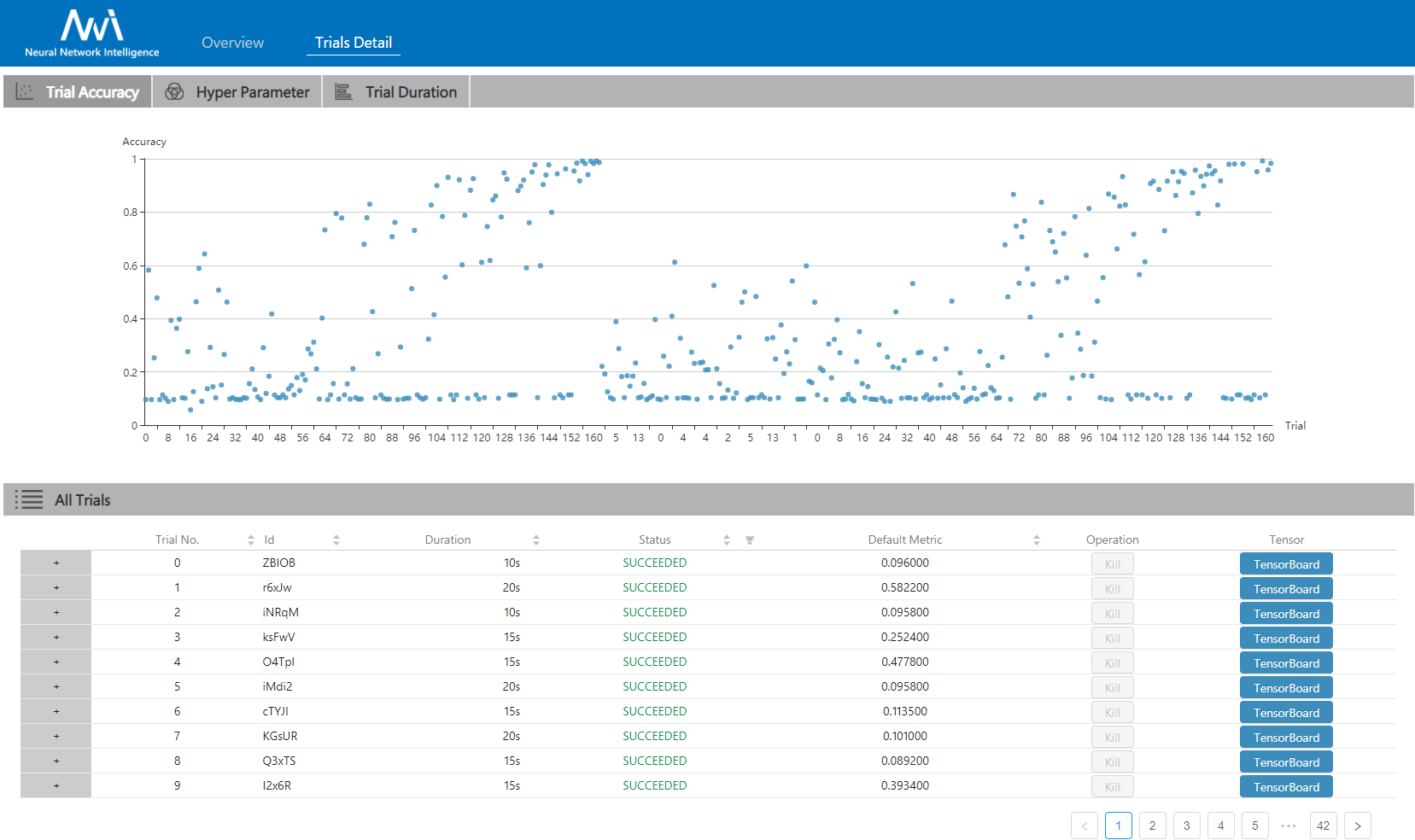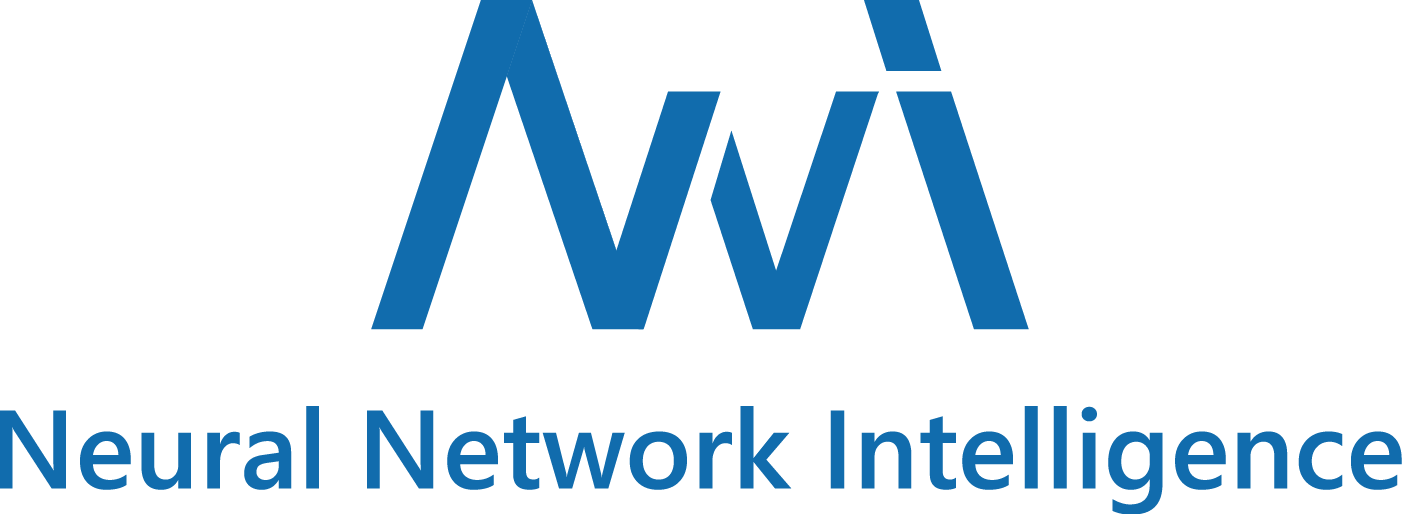NNI (Neural Network Intelligence) is a toolkit to help users run automated machine learning (AutoML) experiments. The tool dispatches and runs trial jobs generated by tuning algorithms to search the best neural architecture and/or hyper-parameters in different environments like local machine, remote servers and cloud.
NNI v1.0 has been released! 
Frameworks & Libraries

|
Tuning Algorithms

|
Training Services

|
|
| Built-in |
|
Tuner Assessor |
|
| References |
- Those who want to try different AutoML algorithms in their training code (model) at their local machine.
- Those who want to run AutoML trial jobs in different environments to speed up search (e.g. remote servers and cloud).
- Researchers and data scientists who want to implement their own AutoML algorithms and compare it with other algorithms.
- ML Platform owners who want to support AutoML in their platform.
Targeting at openness and advancing state-of-art technology, Microsoft Research (MSR) had also released few other open source projects.
- OpenPAI : an open source platform that provides complete AI model training and resource management capabilities, it is easy to extend and supports on-premise, cloud and hybrid environments in various scale.
- FrameworkController : an open source general-purpose Kubernetes Pod Controller that orchestrate all kinds of applications on Kubernetes by a single controller.
- MMdnn : A comprehensive, cross-framework solution to convert, visualize and diagnose deep neural network models. The "MM" in MMdnn stands for model management and "dnn" is an acronym for deep neural network.
- SPTAG : Space Partition Tree And Graph (SPTAG) is an open source library for large scale vector approximate nearest neighbor search scenario.
We encourage researchers and students leverage these projects to accelerate the AI development and research.
Install through pip
- We support Linux, MacOS and Windows (local, remote and pai mode) in current stage, Ubuntu 16.04 or higher, MacOS 10.14.1 along with Windows 10.1809 are tested and supported. Simply run the following
pip installin an environment that haspython >= 3.5.
Linux and MacOS
python3 -m pip install --upgrade nniWindows
python -m pip install --upgrade nniNote:
--usercan be added if you want to install NNI in your home directory, which does not require any special privileges.- Currently NNI on Windows support local, remote and pai mode. Anaconda or Miniconda is highly recommended to install NNI on Windows.
- If there is any error like
Segmentation fault, please refer to FAQ
Install through source code
- We support Linux (Ubuntu 16.04 or higher), MacOS (10.14.1) and Windows (10.1809) in our current stage.
Linux and MacOS
- Run the following commands in an environment that has
python >= 3.5,gitandwget.
git clone -b v1.0 https://github.com/Microsoft/nni.git
cd nni
source install.shWindows
- Run the following commands in an environment that has
python >=3.5,gitandPowerShell
git clone -b v1.0 https://github.com/Microsoft/nni.git
cd nni
powershell -ExecutionPolicy Bypass -file install.ps1For the system requirements of NNI, please refer to Install NNI
For NNI on Windows, please refer to NNI on Windows
Verify install
The following example is an experiment built on TensorFlow. Make sure you have TensorFlow installed before running it.
- Download the examples via clone the source code.
git clone -b v1.0 https://github.com/Microsoft/nni.gitLinux and MacOS
- Run the MNIST example.
nnictl create --config nni/examples/trials/mnist/config.ymlWindows
- Run the MNIST example.
nnictl create --config nni\examples\trials\mnist\config_windows.yml- Wait for the message
INFO: Successfully started experiment!in the command line. This message indicates that your experiment has been successfully started. You can explore the experiment using theWeb UI url.
INFO: Starting restful server...
INFO: Successfully started Restful server!
INFO: Setting local config...
INFO: Successfully set local config!
INFO: Starting experiment...
INFO: Successfully started experiment!
-----------------------------------------------------------------------
The experiment id is egchD4qy
The Web UI urls are: http://223.255.255.1:8080 http://127.0.0.1:8080
-----------------------------------------------------------------------
You can use these commands to get more information about the experiment
-----------------------------------------------------------------------
commands description
1. nnictl experiment show show the information of experiments
2. nnictl trial ls list all of trial jobs
3. nnictl top monitor the status of running experiments
4. nnictl log stderr show stderr log content
5. nnictl log stdout show stdout log content
6. nnictl stop stop an experiment
7. nnictl trial kill kill a trial job by id
8. nnictl --help get help information about nnictl
-----------------------------------------------------------------------
- Open the
Web UI urlin your browser, you can view detail information of the experiment and all the submitted trial jobs as shown below. Here are more Web UI pages.
 |
 |
|---|
Our primary documentation is at here and is generated from this repository.
Maybe you want to read:
- Install NNI
- Use command line tool nnictl
- Define a trial
- Config an experiment
- Define search space
- choose tuner/search-algorithm
- Use annotation
- Use NNIBoard
- Run an experiment on local (with multiple GPUs)
- Run an experiment on OpenPAI
- Run an experiment on Kubeflow
- Run an experiment on multiple machines
- Try different tuners
- Try different assessors
- Implement a customized tuner
- Implement a customized assessor
- Implement TrainingService in NNI
- Use Genetic Algorithm to find good model architectures for Reading Comprehension task
- Advanced Neural Architecture Search
This project welcomes contributions and there are many ways in which you can participate in the project, for example:
- Open bug reports.
- Request a new feature.
- Suggest or ask some questions on the How to Debug guidance document.
- Find the issues tagged with 'good first issue' or 'help-wanted', these are simple and easy to start , we recommend new contributors to start with.
Before providing your hacks, you can review the Contributing Instruction to get more information. In addition, we also provide you with the following documents:
- NNI developer environment installation tutorial
- How to debug
- Customize Your Own Advisor
- Customize Your Own Tuner
- Implement customized TrainingService
With authors' permission, we listed a set of NNI usage examples and relevant articles.
-
- Run ENAS with NNI
- Run Neural Network Architecture Search with NNI
- Automatic Feature Engineering with NNI
- Hyperparameter Tuning for Matrix Factorization with NNI
-
- Hyper Parameter Optimization Comparison
- Neural Architecture Search Comparison
- Parallelizing a Sequential Algorithm TPE
- Automatically tuning SVD with NNI
- Automatically tuning SPTAG with NNI
- Blog (in Chinese) - AutoML tools (Advisor, NNI and Google Vizier) comparison by @gaocegege - 总结与分析 section of design and implementation of kubeflow/katib
- Discuss on the NNI Gitter in NNI.
- File an issue on GitHub.
- Ask a question with NNI tags on Stack Overflow.
The entire codebase is under MIT license






